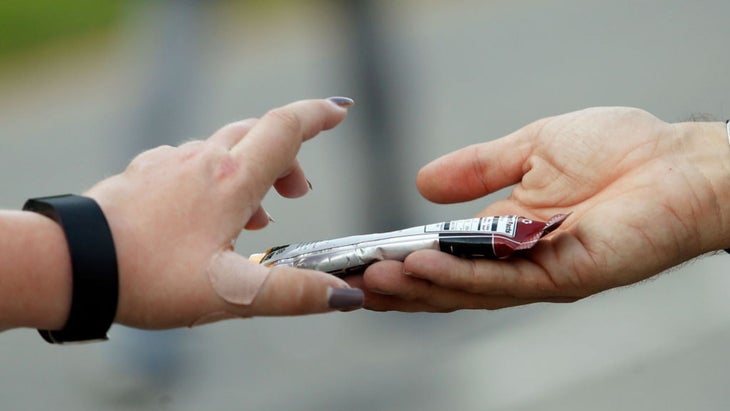“], “filter”: { “nextExceptions”: “img, blockquote, div”, “nextContainsExceptions”: “img, blockquote, a.btn, a.o-button”} }”>
New perk: Easily find new routes and hidden gems, upcoming running events, and more near you. Your weekly Local Running Newsletter has everything you need to lace up!
>”,”name”:”in-content-cta”,”type”:”link”}}”>Subscribe today.
I ran my first half marathon roughly 15 years ago. I was in my early 20s, looking for my next physical challenge after a life in team sports. I saw a half marathon as a challenging and exciting goal––in retrospect the first step down the irresistibly addictive path that is endurance sports. So I was thrilled when I crossed the finish line in beautiful downtown Cleveland, despite the fact that I went into it with about as much planning as an impulsive, sugar-addled toddler climbing up a tree with no idea how they’ll get down.
At the time, I couldn’t imagine going a single step further than a half marathon. I thought a marathon would be unnecessarily masochistic. (You see where this is heading.) Trail races in upper 20 and 30-kilometer distances soon followed and I ran the Berlin Marathon in 2021. Now, I run marathons and ultras. I’ve gotten to the point where heading out for a 13.1-mile run is simply part of my training.
I offer this two-paragraph personal exposition because I think many runners can relate. Once you settle into these longer distances, it’s easy to lose respect for the half marathon race distance, because it’s a distance you’ll regularly cover in a marathon training plan. But heed my caution: going into a half marathon race too casually—without a proper fueling and hydration plan—can be disastrous, especially if you have any expectations of pushing yourself to a PR.
RELATED: Take the “You vs. the Year 2025” Running Challenge
Ryan Hall, retired marathoner-turned coach who set the U.S. record in the half marathon with a time of 59:43 at the Houston Half Marathon in 2007, says fueling for a half marathon is a good example of the differences in approach between pro runners and those who run a half in 75 minutes or longer.
“In theory, if you are running under an hour you don’t need to take in additional fuel and possibly not even water if the conditions are not too hot and humid,” he explains. “I didn’t take in fluids or carbs when I set the American record in the half.”
That might sound like an endorsement to just toe up to the starting line and book it, but it’s important to be honest with yourself. Are you running a half in under 75 minutes? In other words, are you an elite runner in the top one percent?
RELATED: Run Your First—or Best—Half Marathon with This Comprehensive Training Guide
“But it’s just a half—do I really need to fuel?”

Kristin LaFontaine is a certified sports nutritionist from Golden, Colorado, who has been working with runners since 2020 to improve their daily and performance nutrition so they can tackle their biggest running goals.
She’a run 21 marathons but has recently been focusing on the half marathon to try and knock out a new PR.
LaFontaine suggests most runners will benefit from taking on additional fueling during a half marathon because most runners burn through their glycogen stores in about 90 minutes. For runners aiming to finish a half marathon in the 1:45-2:30 range, that means even if you reach the starting line with a relatively full carb load, you run the risk of emptying the tank and running on fumes.
So to run a strong half marathon and avoid bonking in the second half of the race, you’ll need some additional carbs in the form of gels, chews, or drinks. Knowing that you’re optimally fueling can give you confidence to keep racing as hard as you’re able to without fear of bonking.
“This is especially true for athletes running closer to that 1:50 to 2-plus hour half,” she explains. “Even for those athletes running close to or sub 1:30, taking in carbs during a race can give both a physical and mental boost.”
Hall tends to look at the faster spectrum of half marathon runners. From his perspective, it’s not as simple as saying, “you need fuel if you run longer than 75 minutes.”
For him, it’s all about the race prep––eating and drinking enough leading up to the big day. But as he says, nerves often keep athletes from eating and drinking enough going into these events. So they show up to the start line under fueled and dehydrated. That’s when LaFontaine’s advice to pop in a chew or a gel becomes essential.
That said, you shouldn’t just show up with some gels or chews in hand as an emergency back up. Just as you would practice your nutrition leading up to a marathon or an ultra, you need to do the same when training for a half marathon all the way up to the day before.
RELATED: 5 Key Workouts to Nail the Marathon and Half Marathon
LaFontaine likes to keep things simple. She recommends fueling (with gels, chews, fluids, or whole food) roughly every 30 minutes, aiming for 25-30 grams of carbohydrates each fueling session for at least 50 grams an hour. And you should be practicing this during your training runs. Her rule of thumb is to fuel for any run more than 70 minutes. Of course, needs and results vary from person to person, but that’s a solid place to start.
When it comes to hydration, specifications vary even more wildly.
“Sweat rate and composition are genetic, so even two athletes at the same race in the same weather may have different needs,” she explains. “That said, during hard race efforts, most of us are only going to be able to take in around 5-10 ounces per hour. For training runs, I would recommend carrying hydration on runs over 60-70 minutes, especially hot weather runs. Intake amounts vary but most of us will top out at around 20 ounces an hour. More than that becomes difficult to carry and absorb.”
In the end, faster, experienced marathoners can probably get away with skipping gels, chews, and even water during a half marathon. But it’s neither healthy nor beneficial to your performance, unless your goal is to just slither across the finish line and suffer the consequences of dehydration and ill-recovery later.
RELATED: 6 Things to Remember About Fueling for a Half Marathon
“I’d say that there is a big difference between what one can get away with and still cover the distance compared to optimizing performance,” Hall says. “If optimizing performance is the goal, then hydration and carb intake should be played with in training to see what is optimal.”
And if that half marathon you’re signed up for isn’t your goal race, it’s still an opportunity to practice your fueling and hydration plan.
“The gut is trainable,” LaFontaine says. “Use your half marathon to train it to take in fuel and hydration during hard, all-out efforts that aren’t easily replicable during training. And hey, I bet you’ll feel and perform better during your half as well. It’s really a win-win.”
